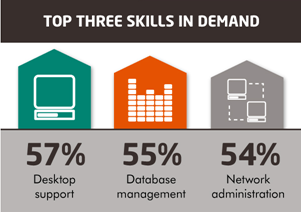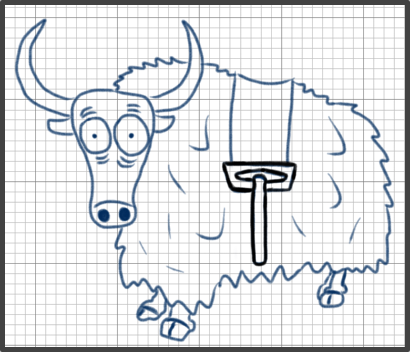限られたネットワークスタッフを拡大する方法: ヤクを駆除する
テクノロジー業界では、セキュリティにおける「スキルギャップ」について嘆く声が数多く聞かれます。 それは、あらゆる垂直産業でますます重要になるポジションを埋められる有能なセキュリティ専門家を見つけることができないという組織の問題です。
しかし、ネットワークなど、他のテクノロジー関連分野におけるスキルギャップについてはあまり言及されていません。
IT業界全体の給与とスキルを追跡しているロバート・ハーフ・テクノロジーは最近、2016年の調査結果を発表し、国内で「ネットワーク」人材をめぐる競争が激化しているようだと明らかにした。

2016 年の最初のレポートによると、「ネットワーク管理」は現在最も需要のある上位 3 つのスキルの 1 つであり、調査対象の CIO の 54% がネットワーク関連の人材の必要性を指摘しています。
それは驚くべきことではない、少なくとも驚くべきことではない。 アプリが増えれば、サーバーとユーザーも増えます。 サーバーとユーザーが増えると、ネットワークも増えます。 ネットワークが拡大するということは、アプリの配信中に問題が発生する可能性のあるさまざまな事柄をプロビジョニング、監視、管理、トラブルシューティングするために必要なネットワーク管理者の数が増えることを意味します。
今日の生産性と利益は、高速で信頼性の高いネットワークにかかっています。 つまり、ルーティングとスイッチングだけでなく、配布(負荷分散)とパフォーマンス強化(キャッシュと TCP 多重化)サービスも、企業向けか消費者向けかを問わず、ユーザーとアプリ間でアプリがやり取りする必要があります。
しかし、こうしたサービスやネットワークには人材が必要です。 ネットワークを設計する方法、適切な場所にポリシーを適用する方法、規模やセキュリティ、速度など、特定の問題を最も効果的に解決できるサービスを決定する方法などを理解している人材が必要です。
どうやらそういう人材は不足しているようだ。 そのため、より多くのネットワーク人材が必要であることを認識している CIO にとって、運用規模は不可欠です。 開発者と同じくらい頻繁にネットワーク担当者の生活で発生するヤクシェービング*の多くを自動化および調整するためのツールを提供することで、CIO は貴重な (そして限られた) ネットワーク専門家の能力を拡大することができます。 「退屈な」作業に費やす時間を減らすと、生産性が向上するだけでなく、役割に対する満足度も高まるという副次的なメリットがあります。 これにより、ネットワーク担当者の離職率を削減できる可能性があります。ネットワーク担当者の離職率は、新規採用者のトレーニングと教育に時間と費用を費やす必要があるあらゆる業界と同様に、IT 組織にとってもコストのかかる問題です。
CAP の調査によると、中程度の給与 (30,000 ~ 50,000 ドル) のポジションの人材を補充するのにかかる平均コストは、年間給与の 20% です。 たとえば、4 万ドルのマネージャーを交代するには 8,000 ドルのコストがかかります。 同じ調査では、「高度なスキル」を要する職種(医師と経営幹部を除く)を平均化して、代替コストが 20.7% とごくわずかに高いことが判明しました。 いずれにせよ、特定の分野の IT 職の給与が「中間層」の範囲外であることは誰もが知っています。 彼らの代わりの人材を雇用するには給与の 20% が必要で、環境について「理解する」までの間、生産性にも影響が出ると見込まれます。

したがって、CIO がネットワーク関連の職に新しい人材を採用するのに苦労しているという問題だけではなく、すでに雇用している人材をどのように維持 (および拡大) するかを考えることも問題です。 退屈で面倒なタスクを排除し、イノベーション(およびマイクロサービスやコンテナ化などの新しいアプリ アーキテクチャをサポートするために必要なネットワークの適応と設計)にさらに多くの時間を割り当てることは、スキル ギャップに対処するために重要です。
CIO は、自動化とオーケストレーション (DevOps、SDx、夕食に遅れたなどと呼んでも構いませんが、戦略計画から欠落しているとは言わないでください) を、新しいアプリ (またはアプリの新しいバージョン) を迅速に市場に提供し、クラウド (オンプレミスとオフプレミスの両方) をサポートするビジネスの能力を向上させるだけでなく、限られた有能なネットワーク専門家の需要の高まりに直面してネットワークを拡張するという課題に対処する手段として採用する必要があります。
API、テンプレート、データ センター オーケストレーションは、ネットワークをより迅速かつ頻繁にスケール アウトするニーズに対応し、ネットワーク エンジニアを疲弊させることなくスケール アウトするニーズに対処するための鍵となります。
これは重要なことです。なぜなら、毛を剃られるのを待っている間にヤクが踏みつけにしなければ、柵の向こう側の芝生は実際にはもっと青く見えるかもしれないからです。
*初心者のために説明すると、ヤクの毛刈りには関連する定義がいくつかあり、最も簡潔な定義は、仕事を遂行するために完了しなければならないタスクです。 最も一般的な例は、完成したコードをテストするために Web サーバーを構成、起動、トラブルシューティングする必要がある開発者です。 ネットワークでは、負荷分散、アプリのセキュリティ、パフォーマンス関連のサービスなど、より高度なネットワーク サービスを展開するために、新しいネットワーク セグメントを構成してトラブルシューティングする必要が生じる場合があります。
